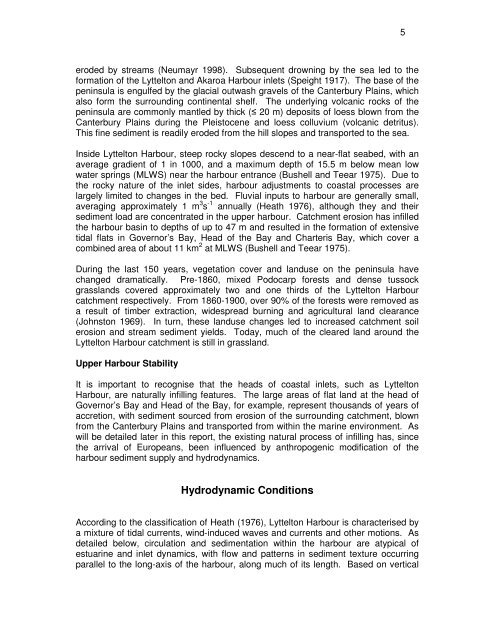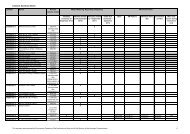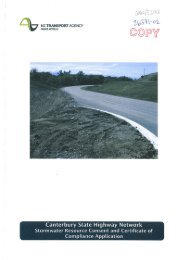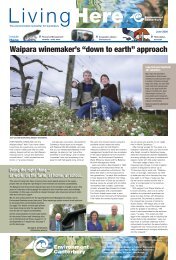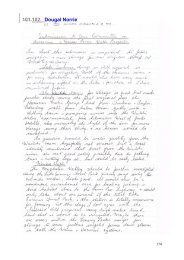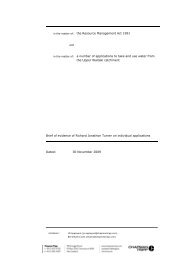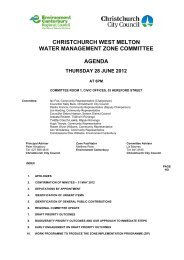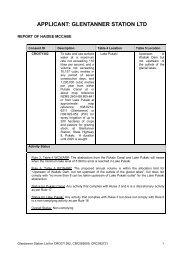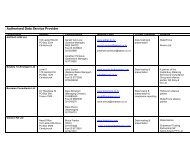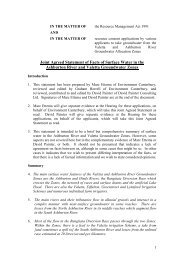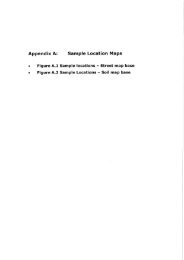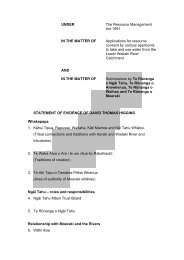Sedimentation in the Upper Lyttelton Harbour - Environment ...
Sedimentation in the Upper Lyttelton Harbour - Environment ...
Sedimentation in the Upper Lyttelton Harbour - Environment ...
Create successful ePaper yourself
Turn your PDF publications into a flip-book with our unique Google optimized e-Paper software.
eroded by streams (Neumayr 1998). Subsequent drown<strong>in</strong>g by <strong>the</strong> sea led to <strong>the</strong><br />
formation of <strong>the</strong> <strong>Lyttelton</strong> and Akaroa <strong>Harbour</strong> <strong>in</strong>lets (Speight 1917). The base of <strong>the</strong><br />
pen<strong>in</strong>sula is engulfed by <strong>the</strong> glacial outwash gravels of <strong>the</strong> Canterbury Pla<strong>in</strong>s, which<br />
also form <strong>the</strong> surround<strong>in</strong>g cont<strong>in</strong>ental shelf. The underly<strong>in</strong>g volcanic rocks of <strong>the</strong><br />
pen<strong>in</strong>sula are commonly mantled by thick ( 20 m) deposits of loess blown from <strong>the</strong><br />
Canterbury Pla<strong>in</strong>s dur<strong>in</strong>g <strong>the</strong> Pleistocene and loess colluvium (volcanic detritus).<br />
This f<strong>in</strong>e sediment is readily eroded from <strong>the</strong> hill slopes and transported to <strong>the</strong> sea.<br />
Inside <strong>Lyttelton</strong> <strong>Harbour</strong>, steep rocky slopes descend to a near-flat seabed, with an<br />
average gradient of 1 <strong>in</strong> 1000, and a maximum depth of 15.5 m below mean low<br />
water spr<strong>in</strong>gs (MLWS) near <strong>the</strong> harbour entrance (Bushell and Teear 1975). Due to<br />
<strong>the</strong> rocky nature of <strong>the</strong> <strong>in</strong>let sides, harbour adjustments to coastal processes are<br />
largely limited to changes <strong>in</strong> <strong>the</strong> bed. Fluvial <strong>in</strong>puts to harbour are generally small,<br />
averag<strong>in</strong>g approximately 1 m 3 s -1 annually (Heath 1976), although <strong>the</strong>y and <strong>the</strong>ir<br />
sediment load are concentrated <strong>in</strong> <strong>the</strong> upper harbour. Catchment erosion has <strong>in</strong>filled<br />
<strong>the</strong> harbour bas<strong>in</strong> to depths of up to 47 m and resulted <strong>in</strong> <strong>the</strong> formation of extensive<br />
tidal flats <strong>in</strong> Governor’s Bay, Head of <strong>the</strong> Bay and Charteris Bay, which cover a<br />
comb<strong>in</strong>ed area of about 11 km 2 at MLWS (Bushell and Teear 1975).<br />
Dur<strong>in</strong>g <strong>the</strong> last 150 years, vegetation cover and landuse on <strong>the</strong> pen<strong>in</strong>sula have<br />
changed dramatically. Pre-1860, mixed Podocarp forests and dense tussock<br />
grasslands covered approximately two and one thirds of <strong>the</strong> <strong>Lyttelton</strong> <strong>Harbour</strong><br />
catchment respectively. From 1860-1900, over 90% of <strong>the</strong> forests were removed as<br />
a result of timber extraction, widespread burn<strong>in</strong>g and agricultural land clearance<br />
(Johnston 1969). In turn, <strong>the</strong>se landuse changes led to <strong>in</strong>creased catchment soil<br />
erosion and stream sediment yields. Today, much of <strong>the</strong> cleared land around <strong>the</strong><br />
<strong>Lyttelton</strong> <strong>Harbour</strong> catchment is still <strong>in</strong> grassland.<br />
<strong>Upper</strong> <strong>Harbour</strong> Stability<br />
It is important to recognise that <strong>the</strong> heads of coastal <strong>in</strong>lets, such as <strong>Lyttelton</strong><br />
<strong>Harbour</strong>, are naturally <strong>in</strong>fill<strong>in</strong>g features. The large areas of flat land at <strong>the</strong> head of<br />
Governor’s Bay and Head of <strong>the</strong> Bay, for example, represent thousands of years of<br />
accretion, with sediment sourced from erosion of <strong>the</strong> surround<strong>in</strong>g catchment, blown<br />
from <strong>the</strong> Canterbury Pla<strong>in</strong>s and transported from with<strong>in</strong> <strong>the</strong> mar<strong>in</strong>e environment. As<br />
will be detailed later <strong>in</strong> this report, <strong>the</strong> exist<strong>in</strong>g natural process of <strong>in</strong>fill<strong>in</strong>g has, s<strong>in</strong>ce<br />
<strong>the</strong> arrival of Europeans, been <strong>in</strong>fluenced by anthropogenic modification of <strong>the</strong><br />
harbour sediment supply and hydrodynamics.<br />
Hydrodynamic Conditions<br />
Accord<strong>in</strong>g to <strong>the</strong> classification of Heath (1976), <strong>Lyttelton</strong> <strong>Harbour</strong> is characterised by<br />
a mixture of tidal currents, w<strong>in</strong>d-<strong>in</strong>duced waves and currents and o<strong>the</strong>r motions. As<br />
detailed below, circulation and sedimentation with<strong>in</strong> <strong>the</strong> harbour are atypical of<br />
estuar<strong>in</strong>e and <strong>in</strong>let dynamics, with flow and patterns <strong>in</strong> sediment texture occurr<strong>in</strong>g<br />
parallel to <strong>the</strong> long-axis of <strong>the</strong> harbour, along much of its length. Based on vertical<br />
5


